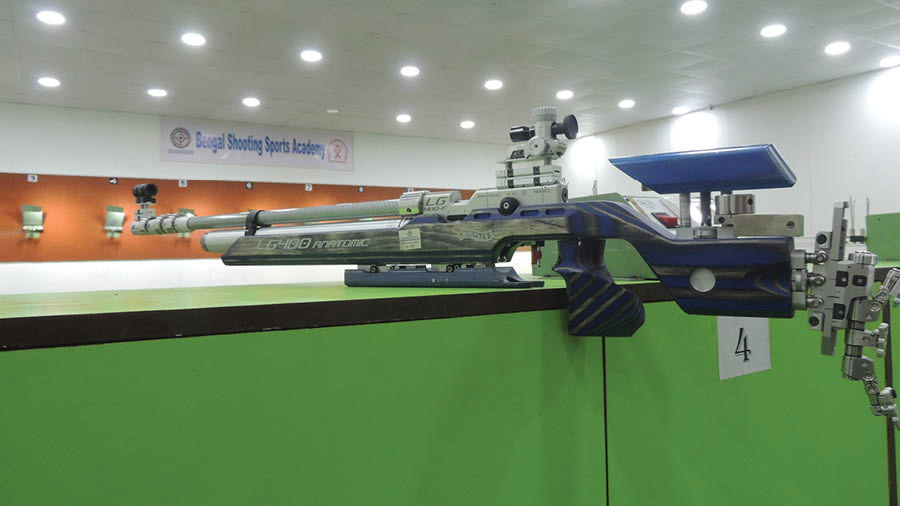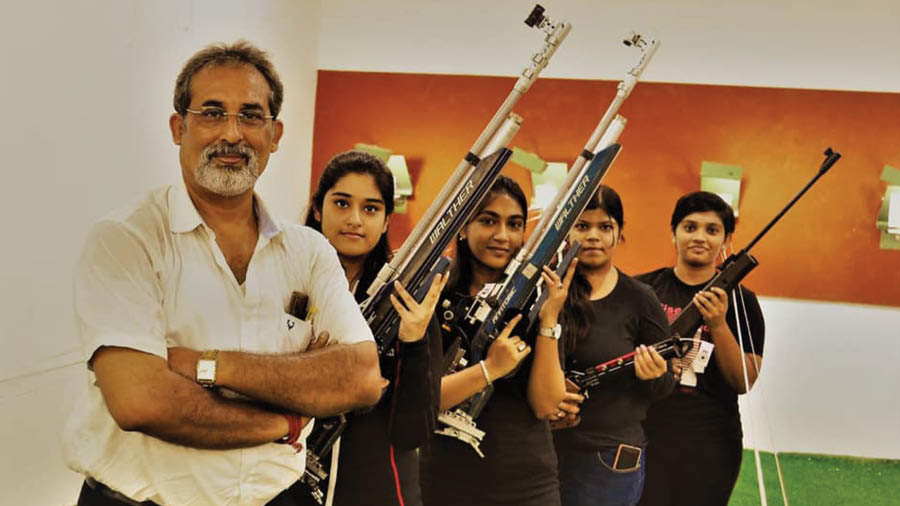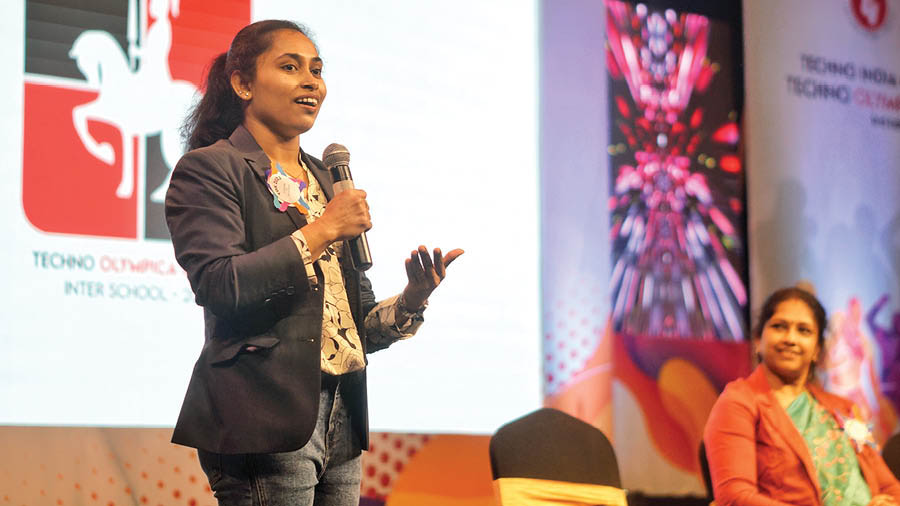Indian athletes representing the discipline of shooting churned out a stellar performance at the recently concluded Asian Games of 2023 held in Hangzhou, China. India’s tally of 22 medals in shooting included seven golds, nine silvers and six bronze medals, which were won by a 33-member contingent. This marked the best-ever performance by Indian shooters at any Asian Games, thereby garnering a renewal of interest in shooting across the country.
Until recently, there were not many opportunities for the sport of shooting in West Bengal. But roughly 20km from the metropolis, on the Bandel line in Khash Bagan, Serampore, lies the Bengal Shooting Sports Academy (BSSA), an institute that provides a pathway for budding shooters. Helmed by two-time South Asian Federation (SAF) Games medallist Joydeep Bandyopadhyay and his equally accomplished partner Ritesh Chakraborty, the range is emerging as a viable platform for those who want to take up shooting professionally.
Bandyopadhyay is currently employed by the Indian Railways and is the honorary chief coach of the academy while Chakraborty is presently the joint secretary of the West Bengal Rifle Association. The two are childhood friends who began their foray into shooting at the Serampore Rifle Club, before participating in senior competitions at the national level and beyond. Intent on sharing their shooting expertise with the next generation, the duo instituted BSSA during the Covid-19 lockdown of 2020. Shooting at the academy is restricted to sports training, with the enrolled students adhering to norms of the National Rifle Association (NRA) and/or the International Shooting Sport Federation (ISSF).
Training at BSSA includes sessions for mental training, yoga, physical fitness, eye exercises, weapon maintenance, and more

Shreya Bandyopadhyay, a fixture at BSSA, who has already represented India Saurav Roy
The facilities at BSSA are tailor-made to cater to international standards as set down by the ISSF. This ensures that local talent from Bengal do not have to compromise in honing their skills in a sport where even the intensity of lighting is factored in during practice. From the height of the tables present before the shooters to the air-conditioning inside the academy, every element of BSSA is maintained rigorously. Open between 1pm and 10pm, six days-a-week (barring Monday), BSSA has also installed a SIUS AG electronic target system that is crucial for modern-day training.
At present, the 40-odd students who make up the strength of BSSA train under three separate coaches, with Bandyopadhyay at the helm of affairs. Twenty-three of these students have already taken part in the 2023 National Shooting Championship. The minimum age for student enrollment is 10 years, which rises to 12 years for those using .22 calibre of ammunition. Some, though, join a lot younger, as an early start always helps even if active competition begins much later. A case in point is Bandyopadhyay’s daughter, Shreya, who is following in her father’s footsteps, having already represented the country on two separate occasions. Training at BSSA also includes special sessions for mental training, yoga, physical fitness, eye exercises, weapon maintenance, stance practice and balancing practice with the use of the specialised Heinz Reinkemeier-designed boards, acknowledged as one of the world’s best coaches for the 10m rifle event.
Elaborating on the workings of the academy to My Kolkata, Bandopadhyay stated: “Students mostly use the Walther rifles from the fabled German company. Their representatives and technicians from their India office in Mumbai regularly come and maintain the ones that are there at the range. This reduces the chances of malfunction of equipment and students can practise without hindrance. It is through the provision of such facilities that we want to level the playing field for shooters in Bengal.”
‘BSSA focuses on the elite events that are played out at the Olympics’

A regular training session at BSSA Facebook/BSSA
Shooting infrastructure in Bengal lags behind considerably when compared to government-aided or government-run facilities in Mumbai, Delhi, Bhopal, Bengaluru, Chandigarh and Odisha. At BSSA, special camps of seven or 15 days are organised frequently to give a better sense of direction to students. In these camps, students can clear doubts, take part in theoretical classes, partake in dry firing, live firing, adjustment of weapons, mental meditation training, and physical training, among other exercises. Guided by its motto of “crafting the sport with science”, BSSA has an intensive scientific focus that includes embracing the latest technology in shooting.
“BSSA focuses on the elite events that are played out at the Olympics, which includes the 10m air rifle for men and women as well as the newly introduced mixed event. For pistol events, there are five events that are approved by the International Sports Federation (ISF), which include some events that are played at the Olympics, such as the rapid-fire pistol,” explained Bandyopadhyay.
At BSSA, basic training is for beginners, where weapons are provided and training is imparted by a specialised national-level player-cum-coach. No fixed time is set for this stage as individual aptitude decides progression. Promising students are identified and moved accordingly from the national to the international level. BSSA offers the necessary contacts and references of national-level participants who retire or leave the sport so that their second-hand sporting weapons can be handed over to younger shooters. There is no licence needed for a 10m air rifle. At BSSA, beginners can practise for 25 days in a month (without any restriction of hours) at Rs 2,250 per month. The sports-grade rifles that are used at BSSA are available at a starting price of Rs 15,000. Students need to procure their own pellets, costing around Rs 400 for a tin of 500 and target paper at 70 paise each. All these are provided by BSSA at cost price, as they procure the same locally.
Keeping up with expensive weapons, competition from states and the civilian handicap

The fabled Walther LG 400 Anatomic air rifle Saurav Roy
“At the advanced level, better weapons are required such as the Walther 400 firearm (the Alutec model) which is used for the Olympics as well. In India, this rifle can be directly imported by an athlete provided they are a registered athlete of the NRA. The weapon comes at a price of Rs 2,40,000, while the second-hand ones can be acquired at around half that price from sportspersons who seek to sell their firearms. The pellets at higher levels also cost more and must be imported from Germany, the UK, or Italy. Additionally, there’s also the requirement of a special type of trousers, gloves, shoes and jackets, which are made in India. The overall gear is engineered to support the body frame better and is available for a total of Rs 40,000. Some shooters may also need special spectacles, which start at Rs 25,000 onwards,” added Chakraborty.
In conclusion, Bandyopadhyay and Chakraborty identified the main concerns pertaining to shooting in Bengal. These include the poaching of talent by other states (particularly Madhya Pradesh and Chandigarh) that have better facilities, bigger budgets and can offer handsome stipends. Although the stage from ideation to implementation is yet to be crossed, the West Bengal state government has been contemplating the implementation of more facilities for shooting and a detailed agenda has been accepted for future progress.
Additionally, civilians who want to get into shooting face the extra hurdle of competing with those from a military background, which often derails the long-term prospects of shooters from Bengal. Notwithstanding these hurdles, BSSA continues steadfastly in its aim of nurturing youngsters by giving them every possible chance to succeed. To say that some of these young shooters may one day make India proud is not to shoot for the stars!

